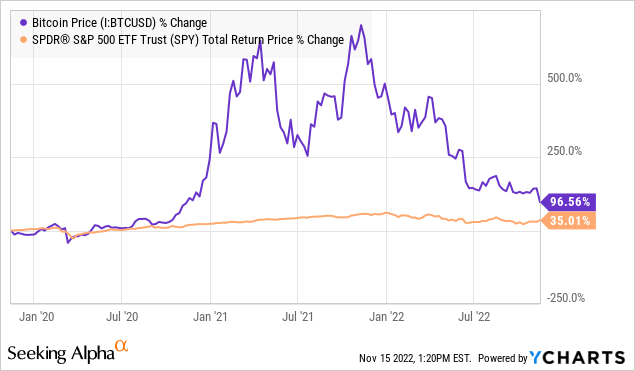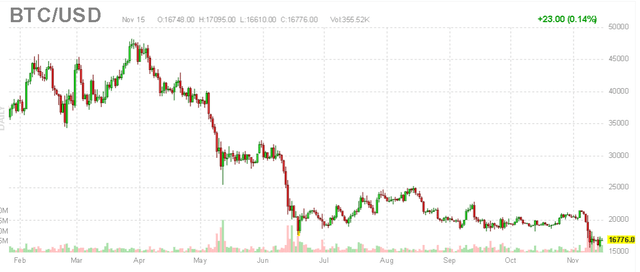
Anthony Kwan/Getty Images News
The collapse of FTX (FTT-USD) from one of the world’s largest crypto exchanges into bankruptcy over just a few days has been disturbing. Despite its air-of-secrecy as a private firm, FTX was seen as one of the few winners going back to the Q2 crash in crypto by making headlines capable of extending lines of credit to more troubled industry players. Indeed, the events of the past week turned out to be the proverbial latest shoe to drop in crypto, sending prices to a new cycle low.
That said, we see a few positives emerging as it relates to the outlook for Bitcoin (BTC-USD) which can consolidate its position as the “gold standard of crypto”. The fall of FTX is more of a story based on possible misbehavior and lack of regulatory compliance than a critique of the potential of digital assets. By this measure, nothing has changed in the long-term bullish case for BTC.
What may be getting lost in the discussion is that the decentralized public blockchain of Bitcoin remains as secure as ever, with the confidence of the protocol helping to affirm its role as a store of value and alternative asset. The setup here is that by getting past this near-term volatility, Bitcoin can emerge stronger into the next bull market.
The Fall of FTX
With the details from the demise in FTX still playing out, the essence of the story has all the hallmarks of a classic bank run. Rumors floating around social media of a liquidity crunch drove a wave of withdrawals from the platform. FTX was forced to halt further transactions based on a lack of adequate capital reserves. The situation was exacerbated based on the group’s dependency on the funding FTT token (FTT-USD) which faced an accelerated selloff, losing more than $7 billion in value over a week.

Seeking Alpha
Disgraced CEO Sam Bankman-Fried tweeted about his misunderstanding of some high-level risk metrics, apparently based on poor internal labeling of bank-related accounts, leaving a substantial deficit in the spread with user margins. The latest update is simply that FTX and its more than 130 affiliates have filed for bankruptcy.
For us, the development came out of left field, in part, because the crypto sector had been building up a sense of stability over the last few months. There wasn’t a market volatility event that triggered the company’s apparent crisis. At the same time, one thought is that this was the final capitulation necessary for the sector to reset and move forward.
Alts are Bad
The way we’re looking at the situation is that the real losers in 2022 are the ecosystem of centralized players and a group of crypto “alts” that have failed to live up to their hype. FTX and its FTT token are the latest, but let’s also remember some of the other failures this year like “Celsius network” (CEL-USD) exposing the risk of “stablecoins” as the terraUSD coin (UST-USD) and LUNA token (LUNC-USD) crashed.
There was also the collapse of crypto lender Voyager Digital (OTCPK:VYGVQ), which was curiously subsequently purchased by FTX in a firesale for $51 million, down from a peak valuation of $1.5 billion. The broader sector has also been plagued by hacks and marketing scams.
Again, the important distinction is that these groups and related alternative cryptocurrencies are unrelated to Bitcoin where the confidence in the security of its peer-to-peer blockchain network underpins its value. There may be other firms to fall and centralized exchange security will always be a concern, but the setup here is that Bitcoin can remain the king of the hill.
Even as bitcoin bulls from the early run in 2020, one of the knocks on the upside price potential was that even with its supply cap of 21 million bitcoins, the universe of alternative cryptocurrencies was unlimited. The allure of alts has always been this underlying hope that “maybe you missed out on Bitcoin’s run from under $1.00 to $10,000”, but that type of return could be possible with the latest and greatest coin gimmick. That type of thinking will likely take a seat from going forward.
While some top-tier alts like Ethereum (ETH-USD), Litecoin (LTC-USD), Ripple (XRP-USD), and Cardano (ADA-USD) have their place with defined utility or unique applications, consider that there are over 9,000 other cryptocurrency examples with many questionable structures. In our view, the bubble in crypto that popped this year was in the atmosphere of tokens being created just for speculative purposes. While we can debate which cryptos are “bad money driving out the good”, FTT and LUNA are just two examples everyone can agree should not have existed.
Bullish on Bitcoin
The way we see it playing out is that more regulation is coming to the sector with an effort of improving security and financial transparency in the name of investor protection. Much of that will likely be targeting crypto finance or DeFi which often utilizes a related token as a critical piece of their blockchain infrastructure. The effect will likely be fewer initial coin offerings going forward with higher thresholds, allowing the current sector leaders to capture a larger share.
All these changes can be positive for Bitcoin because it has already established itself as the most important asset in the public blockchain space. Investors recognizing this dynamic will continue to place BTC higher up on the sector hierarchy, as the target of institutional capital in the digital assets segment. In other words, an investment into BTC can be seen as having a better return to risk profile compared to any other crypto alt or especially over crypto finance startups.
It’s worth recapping some of the high-level secular trends that support both increasing adoption of Bitcoin and higher price long-term. First, the concept of BTC being digital gold is alive and well. Like any other asset class, there are risks but Bitcoin can play an important role in the context of a diversified portfolio for all investors.
The move by high-profile institutional asset managers to facilitate the adoption of crypto has moved forward. Everyone from JPMorgan Chase & Co (JPM), Blackrock Inc (BLK), to Goldman Sachs (GS) offer crypto-related products and have worked to facilitate investor access making crypto more legitimate. An important milestone in the regulatory framework has already moved forward as an important foundation in the U.S. and globally.
Second, adoption is increasing. Over the last few years has proven BTC as an effective form of decentralized non-state money. Reports of consumers utilizing bitcoin for international remittances in emerging markets highlight its global appeal. Its ability to transcend the traditional financial system is useful to a large number of potential users. The collapse of FTX or any token doesn’t change that.
The point we’re getting at here is that Bitcoin is here to stay and its outlook is possibly stronger than ever. As bad as the correction and extreme volatility has been, keep in mind that BTC is still outperforming the S&P 500 (SPY) from levels before the pandemic nearly 3-years ago. The recent performance is all relative. There are several “blue-chip” stocks that have dropped farther in percentage terms from their 2021 highs.

BTC Price Forecast
We mentioned being surprised by the FTX news and a case could be made that if there was ever a spot for the bottom to completely fall out, this was it. By this measure, it’s encouraging that BTC currently trading around $17,000 is off by just a few points from its June low suggesting an underlying level of support, with long-term investors still holding on.

source: finviz.com
The next few weeks will be important regarding any immediate fallout from the FTX bankruptcy. We want to avoid any headlines of other major companies sinking on this matter, but recognizing the price action in the crypto sector will lead the story. Staying above last week’s low of $15,632 in BTC is a good first step. The main risk right now is that an even bigger shoe drops, which would point to some sign of a more structural weakness in crypto.
Fast forward, other macro indicators look more favorable. An outlook for declining inflation with stabilizing interest rates has already helped to kickstart a pullback in the U.S. Dollar that had been trading particularly strongly. A weaker USD by definition should be positive for all foreign currencies and crypto like Bitcoin. In a scenario where risk sentiment improves in financial markets through 2023, supported by better-than-expected macro data, we believe Bitcoin as a high-beta trade will outperform the upside. The first target here will be $20k as a critical technical level to cross.


Be the first to comment